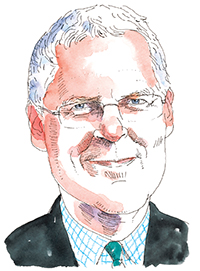Never miss a story — sign up for PLANSPONSOR newsletters to keep up on the latest retirement plan benefits news.
 Art by Joseph CiardielloTo me, the most bizarre element of the complaint against Intel, accusing plan fiduciaries of breaching their Employee Retirement Income Security Act (ERISA) duty of prudence by investing target-date fund (TDF) assets in hedge funds and private equity, was its repeated citation of a Morningstar report that Intel’s 2030 TDF “underperformed peers by approximately 400 basis points (4%) in 2013.”
Art by Joseph CiardielloTo me, the most bizarre element of the complaint against Intel, accusing plan fiduciaries of breaching their Employee Retirement Income Security Act (ERISA) duty of prudence by investing target-date fund (TDF) assets in hedge funds and private equity, was its repeated citation of a Morningstar report that Intel’s 2030 TDF “underperformed peers by approximately 400 basis points (4%) in 2013.”
Anyone who takes the trouble to actually read that Morningstar report will find that it rates Intel’s fund as “above average.” With respect to the alleged underperformance, the report states: “These cautious strategies [including the fund’s hedge fund investments] mean the fund is less likely to keep pace with competitors amid stock market booms. … The occasional periods of underperformance don’t weaken the case for including these alternative strategies and asset classes. Indeed, providing exposure to various sources of risk and returns should help the fund generate better risk-adjusted returns over the long run.”
There is abroad in our world a notion that the best way for a defined contribution (DC) plan fiduciary to avoid getting sued is to provide a low-fee all-passive investment lineup. All the literature being consumed in the 401(k)-fees-are-too-high feeding frenzy focuses on returns on the S&P 500. So why don’t we just concede: yes, the S&P 500 (aka U.S. large cap) represents an incredibly efficient market that is pretty hard to beat with active investment strategies. Is anyone seriously suggesting that all 401(k) assets should be invested only in U.S. large cap?
Have any of the fees-are-too-high scolds taken a look at the bond market? Liquidity challenges are exacerbating what was already a fragmented and not-particularly-transparent market. With respect to equities—are we only to invest in 500 (or 1,000) companies? And are we going to let those companies issue paper without any critical analysis of its value? Does anyone seriously think that you can do without some active management in small cap or emerging markets?
NEXT: Discouraging innovationIntel has for some time been credited as an innovator in 401(k) investment design, finding creative ways to produce target-date solutions that are more efficient than the off-the-rack products sold by the big mutual fund houses. It included hedge funds to reduce risk. Quoting Morningstar: “The addition of hedge funds and commodities provide diversification benefits and reduce investment risk by investing in assets whose returns are less correlated to equity markets.”
It is spectacularly ironic that this company, which has made such an effort to improve 401(k) investment results, is now being beaten about the head and shoulders because, according to the Intel plaintiff, its fund did not perform as well as Fidelity’s or T. Rowe’s TDFs.
In 401(k) plans we are faced with a significant agency problem. Unlike defined benefit (DB) plans, where a sponsor has a direct incentive to get the best investment performance (because the sponsor must make up any shortfalls), DC sponsors have no direct interest in 401(k) investment performance. Our only tools to improve investment performance are ERISA’s fiduciary rules and exhortation. In this context, the easiest thing for a sponsor to do is “whatever is least likely to get me sued.”
I’m going to go out on a limb here: I believe that any investment policy founded on avoiding lawsuits is going to produce mediocre results. Always. And if you allow lawsuits based, fundamentally, on a claim that a fiduciary is pursuing an unusual strategy, no fiduciary will ever innovate.
This is not to say that there are not meaningful issues with respect hedge fund investments in 401(k) plans. My list would include: (1) lack of transparency, both with respect to investments and fees; (2) possible lack of liquidity; and (3) problems with valuation.
I know the Department of Labor (DOL) is obsessed with fees and (it seems) views them as the major drain on 401(k) investment returns. And maybe they are. They certainly are if you believe (as some in this administration seem to) that active management cannot improve on the returns produced by an all-passive strategy. But fiduciary litigation is a very crude way of dealing with this issue and, IMHO, is likely to do more harm than good.
Here’s what I think: the DOL should file an amicus in this suit stating unequivocally that the sorts of innovations that Intel has undertaken—very much including using strategies to protect against downside risk that may result in lagging performance in “up” markets—are absolutely within the range of permissible ERISA “prudence.” Is it too much to ask the DOL to affirm, as Morningstar states in its report on the Intel fund, that: “Active managers have the flexibility to invest in areas where valuations or growth prospects are more attractive and to not invest, or limit exposure, in areas that are less attractive.”
Or have we gotten to the point, with this administration, that “active=imprudent?” Where is that in ERISA?
Michael Barry is president of the Plan Advisory Services Group, a consulting group that helps financial servicescorporations with the regulatory issues facing their plan sponsor clients. He has 40 years’ experience in the benefits field, in law and consulting firms, and blogs regularly about retirement plan and policy issues.
This feature is to provide general information only, does not constitute legal or tax advice, and cannot be used or substituted for legal or tax advice. Any opinions of the author do not necessarily reflect the stance of Asset International or its affiliates.




